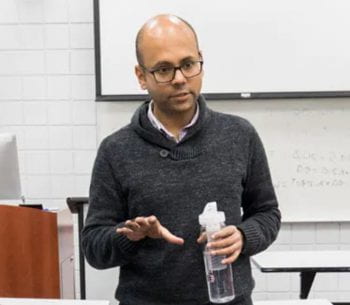Motor Control & Brain Plasticity Journal Club
12/10/2020 at 12PM CST
Topic: Novel Biomarker of movement quality

Associate Professor, Director of Research
Physical Therapy Department
University of North Georgia
Selected reading:
Movement Quality: A Novel Biomarker Based on Principles of Neuroscience
Abstract: A major problem in neurorehabilitation is the lack of objective outcomes to measure movement quality. Movement quality features, such as coordination and stability, are essential for everyday motor actions. These features allow reacting to continuously changing environment or to resist external perturbations. Neurological disorders affect movement quality, leading to functionally impaired movements. Recent findings suggest that the central nervous system organizes motor elements (eg, muscles, joints, fingers) into task-specific ensembles to stabilize motor tasks performance… full article
01/14/2021 at 12PM CST
Topic: OPTIMAL theory of motor learning

Adjunct Assistant Professor of Clinical Physical Therapy, Division of Biokinesiology and Physical Therapy
University of Southern California
Selected reading:
Optimizing performance through intrinsic motivation and attention for learning: The OPTIMAL theory of motor learning
Abstract: Effective motor performance is important for surviving and thriving, and skilled movement is critical in many activities. Much theorizing over the past few decades has focused on how certain practice conditions affect the processing of task-related information to affect learning. Yet, existing theoretical perspectives do not accommodate significant recent lines of evidence demonstrating motivational and attentional effects on performance and learning. … full article
01/28/2021 at 12PM CST
Topic: Whether building something means you understand it

Professor of Philosophy and Philosophy-Neuroscience-Psychology
Washington University in Saint Louis
Selected reading:
Prosthetic models
Abstract: What are the relative epistemic merits of building prosthetic models versus building nonprosthetic models and simulations? I argue that prosthetic models provide a sufficient test of affordance validity, that is, of whether the target system affords mechanisms that can be commandeered by a prosthesis. In other respects, prosthetic models
are epistemically on par with nonprosthetic models… full chapter
02/11/2021 at 12PM CST
Topic: Disruption in visuomotor coordination in stroke survivors

Assistant Professor
Kinesiology Department
Penn State University
Selected reading:
Eye Movements Interfere With Limb
Motor Control in Stroke Survivors
Abstract: Humans use voluntary eye movements to actively gather visual information during many activities of daily living, such as driving, walking, and preparing meals. Most stroke survivors have difficulties performing these functional motor tasks, and we recently demonstrated that stroke survivors who require many saccades (rapid eye movements) to plan reaching movements exhibit poor motor performance. However, the nature of this relationship remains unclear… full article
02/25/2021 at 12PM CST
Topic: Augmenting brain plasticity to enhance motor learning

Assistant Professor
Department of Rehabilitation
Emory University School of Medicine
Selected reading:
Modulatory Effects of Motor State During Paired Associative Stimulation on Motor Cortex Excitability and Motor Skill Learning
Abstract: Repeated pairing of electrical stimulation of a peripheral nerve with transcranial magnetic stimulation (TMS) over the primary motor cortex (M1) representation for a target muscle can induce neuroplastic adaptations in the human brain related to motor learning. The extent to which the motor state during this form of paired associative stimulation (PAS) influences the degree and mechanisms of neuroplasticity or motor learning is unclear. Here, we investigated the effect of volitional muscle contraction during PAS … full article
03/11/2021 at 12PM CST
Topic: Thinking about motor recovery after stroke

Director of Brain, Learning, Animation, and Movement Lab, Professor of Neurology, Neuroscience, & Physical Medicine and Rehabilitation
Johns Hopkins University School of Medicine
Selected Reading:
The Broken Movement: The Neurobiology of Motor Recovery After Stroke (Chapter 3)
Abstract: Stroke is a leading cause of disability in adults and recovery is often difficult, with existing rehabilitation therapies largely ineffective. In Broken Movement, John Krakauer and S. Thomas Carmichael, both experts in the field, provide an account of the neurobiology of motor recovery in the arm and hand after stroke. They cover topics that range from behavior to physiology to cellular and molecular biology. Broken Movement is the only accessible single-volume work that covers motor control and motor learning as they apply to stroke recovery and combines them with motor cortical physiology and molecular biology. The authors cast a critical eye at current frameworks and practices, offer new recommendations for promoting recovery, and propose new research directions for the study of brain repair.
03/25/2021 at 12PM CST
Topic: Synergies during preparation for task switching

Assistant Professor, Motor Control Group
Department of Health and Kinesiology
Purdue University
Selected Reading:
Cue-induced changes in the stability of finger force-production tasks revealed by the uncontrolled manifold analysis
Abstract: A motor system configured to maximize the stability of its current state cannot dexterously transition between states. Yet, we routinely resolve the stability-dexterity conflict and rapidly change our current behavior without allowing it to become unstable before the desired transition. The phenomenon called anticipatory synergy adjustment (ASA) partly describes how the central nervous system handles this conflict. ASA is a continuous decrease in the stability of the current motor state beginning 150 – 400 ms before a rapid state transition accomplished using redundant sets of motor inputs (more input variables than task-specific output variables). So far, ASAs have been observed only when the timing of the upcoming transition is known… full article
04/01/2021 at 12PM CST
Topic: Post-stroke subcortical atrophy and sensorimotor outcomes

Sook-Lei Liew, OTR/L, PhD
Assistant Professor
Chan Division of Occupational Science and Occupational Therapy
USC Stevens Neuroimaging and Informatics Institute
Selected Reading:
Smaller spared subcortical nuclei are associated with worse post-stroke sensorimotor outcomes in 28 cohorts worldwide
Abstract: Up to two-thirds of stroke survivors experience persistent sensorimotor impairments. Recovery relies on the integrity of spared brain areas to compensate for damaged tissue. Subcortical regions play critical roles in the control and regulation of sensorimotor circuits. The goal of this work is to identify associations between volumes of spared subcortical nuclei and sensorimotor behavior at different timepoints after stroke. We pooled high-resolution T1-weighted MRI brain scans and behavioral data in 828 individuals with unilateral stroke from 28 cohorts worldwide. Cross-sectional analyses using linear mixed-effects models related post-stroke sensorimotor behavior to non-lesioned subcortical volumes (Bonferroni-corrected, p<0.004). We tested subacute (≤90 days) and chronic (≥180 days) stroke subgroups separately, with exploratory analyses in early stroke (≤21 days) and across all time. full article
04/08/2021 at 12PM CST
Topic: Goal-directed use of visual feedback

Full Professor
Department of Biomedical and Molecular Sciences
Director of Laboratory of Integrative Motor Behaviour
Queen’s University
Selected Reading:
Visual Feedback Processing of the Limb Involves Two Distinct Phases
Abstract: Muscle responses to mechanical disturbances exhibit two distinct phases: a response starting at ~20 ms that is fairly stereotyped, and a response starting at ~60 ms modulated by many behavioral contexts including goal-redundancy and environmental obstacles. Muscle responses to disturbances of visual feedback of the hand arise within ~90 ms. However, little is known whether these muscle responses are sensitive to behavioral contexts. We had 49 human participants (27 male) execute goal-directed reaches with visual feedback of their hand presented as a cursor. On random trials, the cursor jumped laterally to the reach direction, and thus, required a correction to attain the goal. The first experiment demonstrated that the response amplitude starting at 90 ms scaled with jump magnitude… full article
04/22/2021 at 12PM CST
Topic: Influence of Spasticity on Motor learning and adaptation

Assistant Professor
School of Health Professions
University of San Antonio
Selected Reading:
Spasticity may obscure motor learning ability after stroke
Abstract: Previous motor learning studies based on adapting movements of the hemiparetic arm in stroke subjects have not accounted for spasticity occurring in specific joint ranges (spasticity zones), resulting in equivocal conclusions about learning capacity. We compared the ability of participants with stroke to rapidly adapt elbow extension movements to changing external load conditions outside and inside spasticity zones… full article
04/29/2021 at 12PM CST
Topic: Motor function from a brain-wide perspective: insights from functional imaging

Graduate Student
Dr. Marcus Raichle Laboratory, Neuroimaging Lab
Washington University School of Medicine
Selected Reading:
Hierarchical dynamics as a macroscopic organizing
principle of the human brain
Abstract: Multimodal evidence suggests that brain regions accumulate information over timescales that vary according to anatomical hierarchy. Thus, these experimentally defined “temporal receptive windows” are longest in cortical regions that are distant from sensory input. Interestingly, spontaneous activity in these regions also plays out over relatively slow timescales (i.e., exhibits slower temporal autocorrelation decay). These findings raise the possibility that hierarchical timescales represent an intrinsic organizing principle of brain function. Here, using resting-state functional MRI, we show that the timescale of ongoing dynamics follows hierarchical spatial gradients throughout human cerebral cortex. These intrinsic timescale gradients give rise to systematic frequency differences among large-scale cortical networks and predict individual-specific features of functional connectivity. Whole brain coverage permitted us to further investigate the large scale organization of subcortical dynamics… full article